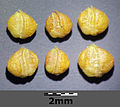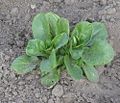Ordinary lamb's lettuce
| Ordinary lamb's lettuce | ||||||||||||
|---|---|---|---|---|---|---|---|---|---|---|---|---|

Common lamb's lettuce ( Valerianella locusta ), illustration |
||||||||||||
| Systematics | ||||||||||||
|
||||||||||||
| Scientific name | ||||||||||||
| Valerianella locusta | ||||||||||||
| ( L. ) Laterr. |
The Common corn salad ( Valeria locusta ), Austrian Vogerlsalat , Swiss lamb's lettuce , also Ackersalat , mouse ear salad , nutlets , Nüssler , Schafmäulchen , sun whirl and Rapunzel called, is a plant of the genus lettuce ( Valerianella ) and belongs to the subfamily of the valerian plants (Valerianoideae).
description
The common lamb's lettuce is an annual , usually winter annual, herbaceous plant that reaches heights of 5 to 15 cm. Its simple leaves are 5 to 30 mm long and are in a basal leaf rosette. Depending on the variety, the leaves are wide or narrow, round or pointed and come in different shades of green. The stem is dichasally branched, square, furrowed and hairy, curved downwards.
The flowers are in small, rounded umbels (dichasias). The small, zygomorphic flowers are five-fold and 1.5 to 2 mm long. The five pale blue petals are fused. There are only three stamens . Three carpels have become an ovary grown. This species can only be identified with ripe fruits. The fruits are small, asymmetrical nuts with a single compartment with a spongy, thickened wall and two deaf fruit compartments as a floating device. The fruit is somewhat compressed on the sides, briefly pointed, rounded, smooth (unripe wrinkled!), With a furrow; it is 2 to 4 mm long.
The number of chromosomes is 2n = 14, 16 or 34.
ecology
The seed germination of this therophyte takes place in autumn after the inhibitors have broken down in summer. The common lamb's lettuce overwinters as a leaf rosette. From April onwards, when the reserves of the rosette leaves are used up, numerous blossoms sprout with blossoms , all of which are fruitful. The flowers are tiny homogamous "funnel flowers". Only a little nectar is formed and secreted in the corolla tube. Pollinators are beetles , two-winged birds , bees and butterflies . Mostly, however, spontaneous self-pollination occurs in that the stigmas are first below and later at the same height as the anthers .
The flowering period is from April to May.
The spread occurs as rain drifts, balloon fliers , people spread as a cultural companion and cultural relic. The fruit ripens in June to July.
Occurrence
The common lamb's lettuce is found in Europe, Macaronesia , northern Africa and western Asia. In other countries it occurs as a neophyte. It thrives on fresh to moderately fresh, nutrient-rich and alkaline-rich, sandy or pure clay soils in a mild, humid winter climate. In Central Europe it occurs primarily in societies of the Sedo-Scleranthetea class, but can also be found in societies of the Polygono-Chenopodietalia order or the Secalietea class.
Systematics
The following subspecies can be distinguished:
- Valerianella locusta subsp. locusta
- Valerianella locusta subsp. lusitanica (Font Quer) M. Laínz (Syn .: Valerianella lusitanica Font Quer ): It occurs in Portugal and Spain.
use
In its cultivated form, lamb's lettuce is eaten as a leaf salad. It is strongly aromatic and some varieties are reminiscent of hazelnut in taste .
Cultivation
The (depending on the variety) mostly winter hardy lamb's lettuce is grown as a subsequent crop both outdoors and in a greenhouse; the harvest can take place from autumn to the end of March of the following year, depending on the time of sowing, due to the plants being shot from April. The yield in the field is around 0.4 kg / m² of cultivation area, in the greenhouse, however, between 1 and 1.5 kg / m².
In the open field, sowing takes place for autumn harvests from July to August and for wintering in the first half of September. Cultivation in unheated greenhouses is also widespread; the most favorable sowing time is here in the first half of September, but is also possible until the end of October.
Depending on the weather, it can be attacked by fungal diseases such as powdery mildew or downy mildew . Varieties that are resistant to both diseases can be used and numerous pesticides are approved.
photos
Habit during the flowering period
swell
Individual evidence
- ↑ a b Erich Oberdorfer : Plant-sociological excursion flora for Germany and neighboring areas . With the collaboration of Angelika Schwabe and Theo Müller. 8th, heavily revised and expanded edition. Eugen Ulmer, Stuttgart (Hohenheim) 2001, ISBN 3-8001-3131-5 , pp. 881 .
- ^ A b E. von Raab-Straube & T. Henning (2017+): Valerianaceae. - In: Euro + Med Plantbase - the information resource for Euro-Mediterranean plant diversity. Data sheet Valerianaceae
- ↑ Valerianella locusta in the Germplasm Resources Information Network (GRIN), USDA , ARS , National Genetic Resources Program. National Germplasm Resources Laboratory, Beltsville, Maryland.
- ↑ Klaus-Ulrich Heyland (editor), S. Scholz, W. Stolz: Special plant cultivation . 7th edition, Ulmer, Stuttgart 1952/1996, ISBN 3-8001-1080-6 , pp. 203 f.
- ↑ Winfried Titze: Fresh vegetables from the garden . Ulmer, Stuttgart 1987, ISBN 3-8001-6293-8 , p. 80 f.
- ^ F. Böhning: Advice for every garden day . Leipzig 1981.
- ↑ Pests: Real powdery mildew on nut lettuce . Plant protection product directory. In: psm. admin.ch , Federal Office for Agriculture , accessed on February 29, 2020.
- ^ Pathogen: Downy mildew of the nut lettuce . Plant protection product directory. In: psm. admin.ch , Federal Office for Agriculture , accessed on February 29, 2020.
literature
- Robert Zander : Zander concise dictionary of plant names. Edited by Fritz Encke , Günther Buchheim, Siegmund Seybold . 15th edition, corrected reprint of the 14th edition. Eugen Ulmer, Stuttgart 1994, ISBN 3-8001-5072-7 .
- Schmeil-Fitschen, interactive, Quelle & Meyer-Verlag, ISBN 3-494-01368-3
- Ruprecht Düll , Herfried Kutzelnigg : Pocket dictionary of plants in Germany. A botanical-ecological excursion companion to the most important species. 6th, completely revised edition. Quelle & Meyer, Wiebelsheim 2005, ISBN 3-494-01397-7 .
Web links
- Ordinary lamb's lettuce. In: FloraWeb.de.
- Ordinary lamb's lettuce . In: BiolFlor, the database of biological-ecological characteristics of the flora of Germany.
- Valerianella locusta (L.) Laterr. In: Info Flora , the national data and information center for Swiss flora .
- Thomas Meyer: Lamb's lettuce data sheet with identification key and photos at Flora-de: Flora von Deutschland
- Entry in Plants for a Future. (English)





